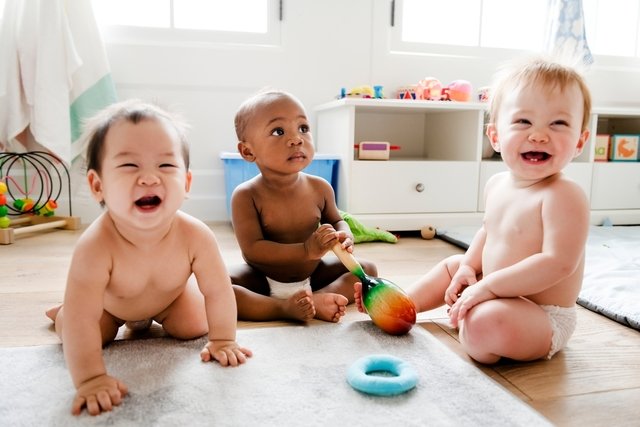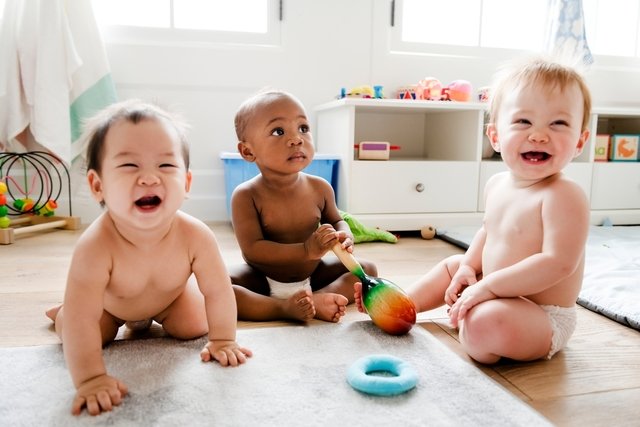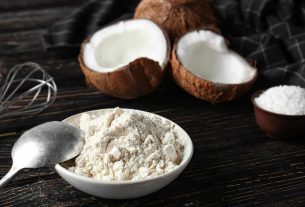6-month-old babies can visually recognize their parents or guardians and family members, as well as knowing how to identify a strange person. At this age, the baby also communicates better, babbling sounds like “ah”, “eh” and “oh”, when they call their name, when they talk to them or when they want to express joy or frustration.
At this stage, the baby can already sit without support, support himself better with his hands, crawl and lie on his back or stomach when lying down. In addition, the baby also supports his feet firmly when placed on his feet.
From 6 months onwards, the baby also begins to eat other foods, such as vegetables, fruits, legumes, cereals and proteins, complementing breast milk or infant formula, according to the guidance of a pediatrician or nutritionist. See how to introduce foods into your baby’s diet.
Each baby is unique and has its own rhythm of growth, sleep and speech. Therefore, if you have any doubts about the baby’s development, it is important to consult your pediatrician.

Baby weight at 6 months
The following table indicates the ideal weight range for a 6-month-old baby, as well as other important parameters such as height, head circumference and weight gain according to the World Health Organization:
It is important to remember that, if the baby presents values above or below those indicated, it is recommended to consult the pediatrician so that the child’s development can be assessed.
How does a baby sleep?
A 6-month-old baby’s sleep lasts approximately 14 hours a day, including the 2 to 3 hours, divided into 2 or 3 naps, that he takes throughout the day. However, at this stage the baby tends to sleep less throughout the day, as he is more interested in interacting with his parents or guardians.
During the night, the baby’s sleeping period is longer, lasting around 9 to 11 hours. However, some babies may have more difficulty sleeping for long hours or may even “change day for night”. In this case, some tips for the baby to have a good night’s sleep are:
- Maintain a routine following the same bedtime;
- Place the baby still awake in the crib, to teach him to “fall asleep” alone;
- Reduce noise in the house at bedtime;
- Keep the baby’s room with low lighting;
- If your baby wakes up too early, rock him in his crib so he can sleep a little longer.
In addition, giving a warm bath close to bedtime or giving a massage can also help your baby get a good night’s sleep.
Baby food at 6 months
According to the Brazilian Society of Pediatrics, it is important to start introducing foods into the baby’s diet from 6 months onwards, which will complement breast milk or infant formula.
For lunch or dinner, porridge made with cereals, tubers, fresh vegetables, protein and legumes should be offered. For morning and afternoon snacks, fresh fruit porridge should be offered, which should be shaved or mashed. See what the baby’s diet should be like and see an example of the menu.
Babies’ meals should be mashed with a fork or scraped (in the case of fruit), to help develop chewing, breathing and recognizing the different flavors and textures of food.
Furthermore, it is recommended that the baby is encouraged to hold the spoon and even pick up food with their own hands, with parental supervision, as this stimulates the development of motor coordination, which is a similar approach to the BLW method. Discover the benefits and see how to start the BLW method.
The Brazilian Society of Pediatrics also recommends that the baby be offered 700 ml of water to avoid constipation and kidney overload, as babies at 6 months begin to eat foods with more fiber, sodium and proteins. See the amount and how to give water to your 6-month-old baby.
Baby development
Babies at 6 months can already visually recognize their parents, or guardians, and family members, as well as knowing when a person is strange. At this stage, the baby also communicates better, babbling sounds like “ah”, “eh” and “oh”, when they call their name, when they talk to them or when they want to express joy or dissatisfaction.
At 6 months, the baby can also sit without support, support himself better with his hands, crawl, crawl and lie on his back or stomach when lying down. In addition, the baby also supports his feet firmly when placed on his feet.
A 6-month-old baby observes things around him better and likes to pick up whatever is within his reach and, out of curiosity, put it in his mouth. Therefore, during this phase it is important that parents or guardians take care to prevent the baby from choking. See how to avoid it and what to do when your baby chokes.
Watch the video below for some tips to help your baby’s development:
Teeth birth
The birth of teeth occurs around 6 months and the symptoms of the birth of the first teeth can be irritability, decreased sleep, reduced appetite, excess saliva and, sometimes, fever.
To alleviate the discomfort of their first teeth, parents or guardians can massage their baby’s gums with their fingertips or give them toys such as teethers to bite on. See how to ease discomfort during baby teething.
When to vaccinate your baby
A 6-month-old baby will need to have some vaccines, such as:
- Third dose of Hepatitis B vaccine;
- Third dose of the Hib vaccine, which protects against infection by the bacteria Haemophilus influenzae;
- Third dose of the VIP vaccine, which protects against infantile paralysis;
- Third dose of the triple bacterial vaccine.
From 6 months onwards, it is also recommended to start immunization against the Influenza virus, which is responsible for the flu.
Games and activities with the baby
Play is important to help develop your baby’s speech, creativity and learning. Furthermore, games promote a greater bond between the baby and their parents or guardians and family members.
Some games and activities that can be done with a 6-month-old baby are:
- Sit together with the baby on a soft rug. Place some toys and objects inside a basket and let the baby remove them one by one, while talking, explaining or making sounds about each object;
- Build a tunnel with a cardboard box, opening the bottom and top. Place the baby on one side of the box and a toy on the other end, calling him to look for the object and encouraging him to crawl across the box.
Furthermore, another activity to stimulate your 6-month-old baby is to walk with him in open places such as parks or squares. However, walks must be done before 10:00 or after 16:00, always applying sunscreen to the baby 20 to 30 minutes before leaving the house, and the use of an umbrella or cap is also recommended.

Sign up for our newsletter and stay up to date with exclusive news
that can transform your routine!
Warning: Undefined array key "title" in /home/storelat/public_html/wp-content/plugins/link-whisper-premium/templates/frontend/related-posts.php on line 12
Warning: Undefined array key "title_tag" in /home/storelat/public_html/wp-content/plugins/link-whisper-premium/templates/frontend/related-posts.php on line 13




